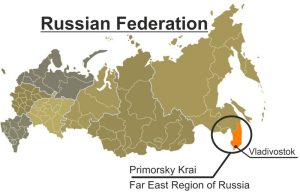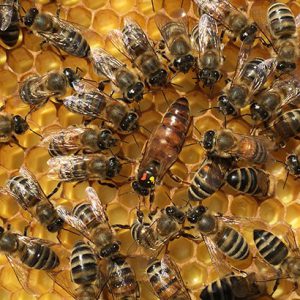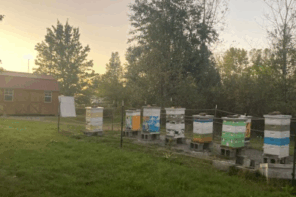 Russian Honey Bees
Russian Honey Bees
By: Clarence Collison
The staff of the USDA, Honey Bee Breeding, Genetics and Physiology lab visited the Primorsky Territory on the Pacific coast of Russia in an effort to find honey bees resistant to Varroa destructor. Initially, work with these bees included preliminary evaluations, detailed study of colonies in Russia, importation of Russian queens through quarantine, a detailed comparison of the response to varroa mite infestations of Russian and Italian colonies, studies of selection for resistance to varroa mites, resistance to tracheal mites and studies of honey production. The emphasis of the program then shifted from identifying breeder lines to intensifying selection within breeder lines (Rinderer et al., 2005).
Russian honey bee queens were first brought into the United States in 1997 for the purpose of genetic improvement of varroa mite resistance in managed honey bee stocks (Rinderer et al., 1997; Rinderer et al., 2005). Yearly importations continued through 2002 to include a total of 362 queens. From tests of individual queens and numerous field trials of groups of siblings, 18 lines in total were established that had resistance to tracheal and varroa mites and good honey production (Rinderer et al., 1997). The lines were divided into three groups of six lines each, to form a closed breeding population having a three-block design. Lines within each block were deliberately crossed with lines from the other two blocks under controlled conditions to promote maintenance of genetically diverse lines. Queens were allowed to free-mate in flight in isolated apiaries on coastal islands containing drones from predetermined sources (from the remaining two blocks). Initial breeding efforts resulted in a release of three lines of improved stock to commercial beekeepers in 2000 (Rinderer et al., 2000). Controlled releases of numerous lines to select beekeepers continued through 2008 (Bourgeois and Rinderer, 2009).
Field trials of Russian honey bees (ARS Primorsky stock) propagated as queen lines from queens imported from the far-eastern province of Primorsky were conducted in 1999 and 2000 in Iowa, Louisiana, and Mississippi. Varroa destructor populations in Primorsky colonies grew more slowly and hence, had fewer numbers than they did in domestic colonies. Colonies of six Primorsky queen-lines evaluated in 1999 averaged about half the number of mites found in domestic control colonies. In 2000, colonies of 10 Primorsky queen lines in Louisiana supported an average V. destructor population growth of 2.5-fold increase across 91 days, far less than the 17.3-fold increase predicted from growth models derived for domestic colonies. Most colonies of the same 10 Primorsky queen-lines in Iowa and Mississippi had no (150 colonies) to very few (48 colonies) detectable V. destructor three months after being inoculated with about 100 mites. Hence, in all trials, ARS Primorsky honey bees showed strong resistance to V. destructor. Variance within and between queen lines indicated good potential to further increase this resistance through selective breeding (Rinderer et al., 2001).

The varroa resistance of several genetic crosses utilizing ARS Russian honey bees was tested in Alabama during 2001. Bee stocks included pure ARS Russian (Russian queens x Russian drones), commercial (commercial queens x commercial drones), Russian hybrids (commercial queens × Russian drones), and SMR-Russian hybrids [(queens bred for the suppression of mite reproduction trait) × Russian drones]. The varroa resistance of Russian hybrids was intermediate to that of pure ARS Russian and commercial stocks. This suggested that Russian hybrids may offer some varroa resistance, but pure ARS Russian stock should be used to achieve the maximum varroa resistance that is currently available in Russian bees. The lowest growth of mite populations occurred in the SMR-Russian hybrids. This may suggest that resistance genes from the two parental types combined in an additive manner, but they could not be sure because pure SMR bees (SMR queens × SMR drones) were not included in the study (Harris and Rinderer, 2004).
The commercial management of ARS Russian honey bees is different from the stocks that beekeepers are familiar with. Requeening is more difficult with some Russian stocks and queens usually take longer to start laying. Russian colonies overwinter well but may have a small cluster size in early Spring. They buildup rapidly after pollen is available and require adequate supering, but shut down brood rearing when resources disappear. Russian honey bees are resistant to both varroa and tracheal mites (Tubbs et al., 2003).
Earlier studies showed that Russian honey bees support slow growth of varroa mite populations. De Guzman et al. (2008) studied whether or not comb type influenced varroa reproduction in both Russian and Italian honey bees, and whether Russian bees produced comb which inhibited varroa reproduction. However, the major differences found in this study concerned honey bee type. Overall, the Russian honey bees had lower (2.44 ± 0.18%) levels of varroa infestation than Italian honey bees (7.20 ± 0.60%). This decreased infestation resulted in part from a reduced number of viable female offspring per foundress in the Russian (0.85 ± 0.04 females) compared to the Italian (1.23 ± 0.04 females) colonies. In addition, there was an effect by the comb built by the Russian honey bee colonies that reduced varroa reproduction. When comparing combs having Russian or Italian colony origins, Russian honey bee colonies had more non-reproducing foundress mites and fewer viable female offspring in Russian honey bee comb. This difference did not occur in Italian colonies. The age of comb in this study had mixed effects. Older comb produced similar responses for six of the seven varroa infestation parameters measured. In colonies of Italian honey bees, the older comb (2001 dark) had fewer (1.13 ± 0.07 females) viable female offspring per foundress than were found in the 2002 new (1.21 ± 0.06 females) and 1980s new (1.36 ± 0.08 females) combs. This difference did not occur with Russian honey bee colonies where the number of viable female offspring was low in all three types of combs. This study suggests that honey bee type largely influences growth of varroa mite population in a colony (De Guzman et al., 2008).
In another study, 32 Russian (RHB) and 14 Italian honey bee colonies were assessed for the Varroa Sensitive Hygienic (VSH) trait using two different assays. Firstly, colonies were assessed using the standard VSH behavioral assay of the change in infestation of a highly infested donor comb after a one-week exposure. Secondly, the same colonies were assessed using an “actual brood removal assay” that measured the removal of brood in a section created within the donor combs as a potential alternative measure of hygiene towards Varroa-infested brood. All colonies were then analyzed for the recently discovered VSH quantitative trait locus (QTL) to determine whether the genetic mechanisms were similar across different stocks. Based on the two assays, Russian colonies were consistently more hygienic toward Varroa-infested brood than Italian honey bee colonies. The actual number of brood cells removed in the defined section was negatively correlated with the Varroa infestations of the colonies (r2 = 0.25). Only two (percentages of brood removed and reproductive foundress Varroa) out of nine phenotypic parameters showed significant associations with genotype distributions. However, the allele associated with each parameter was the opposite of that determined by VSH mapping. In this study, RHB colonies showed high levels of hygienic behavior towards Varroa-infested brood. The genetic mechanisms are similar to those of the VSH stock, though the opposite allele associates in RHB, indicating a stable recombination event before the selection of the VSH stock. The measurement of brood removal is a simple, reliable alternative method of measuring hygienic behavior towards Varroa mites, at least in RHB stock (Kirrane et al., 2015).
The removal of Varroa destructor was assessed in Russian honey bee (RHB) colonies with known levels of Varroa Sensitive Hygienic (VSH) and brood removal activities. The expression of grooming behavior using individual bees was also measured using three groups of RHB displaying different VSH levels: low hygiene (RHB-LH, < 35% VSH), medium hygiene (RHB-MH, 35–70%) and high hygiene (RHB-HH, > 70%). Italian colonies (5.43–71.62% VSH) served as a control. Their results demonstrated, for the first time, significant relationships between two hygienic responses (VSH activity measured as percent change in infestation and the actual brood removal of Varroa-infested donor comb) and two measurements of mite fall (trapped old mites/trapped mites (O/T) and trapped young mites/trapped mites (Y/T)). However, these relationships were only observed in RHB colonies. In addition, the RHB colonies that displayed the highest levels of hygiene (RHB-HH) also groomed longer in response to the presence of a V. destructor mite based on individual bee assays. The positive regressions between the two hygienic measurements and O/T and their negative regressions with Y/T suggest that the removal of infested brood prevented successful mite reproduction, ultimately suppressing V. destructor infestations in the RHB colonies. In addition, it was demonstrated that RHB resistance to V. destructor rests on both an increased hygienic response and the removal of phoretic mites, released by hygienic behavior, through grooming. Both resistance traits are reflected in the O/T and Y/T ratios found in trapped mites from RHB colonies. None of the measurements involving mite injuries were associated with any measurements of hygiene and colony infestations (Kirrane et al., 2018).
Flight activity was compared in colonies of Russian honey bees and Italian bees during commercial pollination of lowbush blueberries (principally Vaccinium angustifolium Aiton) in Washington Co., Maine, in late May and early June in 2003 and 2004. Colonies of the two stocks were managed equally in Louisiana during Autumn through early Spring preceding observations in late Spring each year. Resulting average populations of adult bees and of brood were similar in colonies of the two bee stocks during pollination. Flight during pollination was monitored hourly on six days each year by counting bees exiting each colony per minute; counts were made manually with flight cones on 17 colonies per stock in 2003 and electronically with ApiSCAN Plus counters on 20 colonies per stock in 2004. Analysis of variance showed that temperature, colony size (population of adult bees or brood) and the interaction of these effects were the strongest regulators of flight activity in both years. Russian and Italian bees had similar flight activity at any given colony size, temperature or time of day. Flight increased linearly with rising temperatures and larger colony sizes. Larger colonies, however, were more responsive than smaller colonies across the range of temperatures measured. In 2003, flight responses to varying temperatures were less in the afternoon and evening (1500-1959 hours) than they were earlier in the day. Russian colonies had flight activity that was suitable for late Spring pollination of lowbush blueberries (Danka and Beaman, 2007).
Differences in flight activity and in the percentages of pollen foragers between commercially managed honey bees, of two stocks (USDA-ARS Russian, n=41 colonies; and Italian, n=43 colonies) were evaluated in an almond Prunus dulcis (Miller) orchard in Kern Co., CA during February and March 2002. Flight activity was measured by taking one minute counts of bees exiting colonies on each of nine days. Flight activity was best predicted with a model containing the effects of colony size (populations of adult bees and sealed brood), temperature, time of day, the interaction of adult bee population with temperature and the interaction of adult bee population with time of day. Flight increased linearly with adult bee and brood population, had a quadratic relationship with temperature (increasing, but less so at higher temperatures) and had a quadratic relationship with time of day (decreasing, but less so at later times). Larger colonies had more response to changing temperatures and less response to different times of day than small colonies. Bee type had no direct influence on flight activity at any given colony size, temperature or time of observation or when evaluated using a reduced data set retaining 34 Italian colonies and 32 Russian colonies whose mean sizes were equal. Overall, however, Russian colonies were less populous by about one-fourth and so fielded on average 71% of the foragers that Italian colonies did. Pollen collection was measured by capturing returning foragers on four days. The percentages of foragers with pollen were not different for the bee types (Danka et al., 2006).
Honey bee colonies infested by parasitic mites are more prone to suffer from a variety of stresses, including cold temperature. De Guzman et al. (2005) evaluated the overwintering ability of candidate breeder lines of Russian honey bees, most of which are resistant to both Varroa destructor Anderson & Trueman and Acarapis woodi (Rennie), during 1999-2001. Their results indicated that Russian honey bee colonies (headed by original and supersedure queens) can successfully overwinter in the north, even during adverse weather conditions, owing to their frugal use of food stores and their resistance to tracheal mite infestations. In contrast, colonies of Italian honey bees consumed more food, had more mites and lost more adult bees than Russian honey bees, even during unusually mild Winter conditions.

To compare resistance to small hive beetles between Russian and commercial Italian honey bees, the numbers of invading beetles, their population levels through time and small hive beetle reproduction inside the colonies were monitored. Frake et al. (2009) found that the genotype of queens introduced into nucleus colonies had no immediate effect on small hive beetle invasion. However, the influence of honey bee stock on small hive beetle invasion was pronounced once test bees populated the hives. In colonies deliberately freed from small hive beetle during each observation period, the average number of invading beetles was higher in the Italian colonies (29 ± 5 beetles) than in the Russian honey bee colonies (16 ± 3 beetles). A similar trend was observed in colonies that were allowed to be freely colonized by beetles throughout the experimental period (Italian, 11.46 ± 1.35; Russian, 5.21 ± 0.66 beetles). A linear regression analysis showed no relationships between the number of beetles in the colonies and adult bee population, brood produced or amount of pollen. There were more Italian colonies that supported small hive beetle reproduction than Russian colonies. Regardless of stock, the use of entrance reducers had a significant effect on the average number of small hive beetles (with reducer, 16 ± 3; without reducer, 27 ± 5 beetles). However, there was no effect on bee population (with reducer, 13.20 ± 0.71; without reducer, 14.60 ± 0.70 frames) or brood production (with reducer, 6.12 ± 0.30; without reducer, 6.44 ± 0.34 frames). Overall, Russian honey bees were more resistant to small hive beetle than Italian honey bees as indicated by fewer invading beetles, lower small hive beetle population through time, and lesser reproduction.
References
Bourgeois, A.L. and T.E. Rinderer 2009. Genetic characterization of Russian honey bee stock selected for improved resistance to Varroa destructor. J. Econ. Entomol. 102: 1233-1238.
Danka, R.G. and L.D. Beaman 2007. Flight activity of USDA-ARS Russian honey bees (Hymenoptera: Apidae) during pollination of lowbush blueberries in Maine. J. Econ. Entomol. 100: 267-272.
Danka, R.G., H.A. Sylvester and D. Boykin 2006. Environmental influences on flight activity of USDA-ARS Russian and Italian stocks of honey bees (Hymenoptera: Apidae) during almond pollination. J. Econ. Entomol. 99: 1565-1570
De Guzman, L.I., T.E. Rinderer, M. Bigalk, H. Tubbs and S.J. Bernard 2005. Russian honey bee (Hymenoptera: Apidae) colonies: Acarapis woodi (Acari: Tarsonemidae) infestations and overwintering survival. J. Econ. Entomol. 98: 1796-1801.
De Guzman, L.I., T.E. Rinderer and A.M. Frake 2008. Comparative reproduction of Varroa destructor in different types of Russian and Italian honey bee combs. Exp. Appl. Acarol. 44: 227-238.
Frake, A.M., L.I. De Guzman and T.E. Rinderer 2009. Comparative resistance of Russian and Italian honey bees (Hymenoptera: Apidae) to small hive beetles (Coleoptera: Nitidulidae). J. Econ. Entomol. 102: 13-19.
Harris, J.W. and T.E. Rinderer 2004. Varroa resistance of hybrid ARS Russian honey bees. Am. Bee J. 144: 797-800.
Kirrane, M.J., L.I. De Guzman, B. Holloway, A.M. Frake, T.E. Rinderer and P.M. Whelan 2015. Phenotypic and genetic analysis of the Varroa sensitive hygienic trait in Russian honey bee (Hymenoptera: Apidae) colonies. PLoS ONE 10(4): e0116672. https://doi.org/10.1371/journal.pone.0116672
Kirrane, M.J., L.I. De Guzman, P.M. Whelan, A.M. Frake and T.E. Rinderer 2018. Evaluations of the removal of Varroa destructor in Russian honey bee colonies that display different levels of Varroa Sensitive Hygienic activities. J. Insect Behav. 31:283-297. https://doi.org/10.1007/s10905-018-9672-2
Rinderer, T.E., V.N. Kuznetsov, R.G. Danka, and G.T. Delatte 1997. An importation of potentially varroa-resistant honey bees from far-eastern Russia. Am. Bee J. 137: 787-789.
Rinderer, T.E. L.I. De Guzman, J.W. Harris, V. Kuznetsov, G.T. Delatte, J.A. Stelzer, and L.D. Beaman 2000. The release of ARS Russian honey bees. Am. Bee J. 140: 305-307.
Rinderer, T.E., L.I. De Guzman, G.T. Delatte, J.A. Stelzer, J.L. Williams, L.D. Beaman, V. Kuznetsov, M. Bigalk, S.J. Bernard and H. Tubbs 2001. Multi-state field trials of ARS Russian honey bees. 1. Responses to Varroa destructor 1999, 2000. Am. Bee J. 141: 658-661.
Rinderer, T.E., L. De Guzman, and R. Danka 2005. A new phase begins for the USDA-ARS Russian honey bee breeding program. Am. Bee J. 145: 579-582.
Tubbs, H., M. Harper, M. Bigalk, S.J. Bernard, G.T. Delatte, H.A. Sylvester and T.E. Rinderer 2003. Commercial management of ARS Russian honey bees. Am. Bee J. 143: 819-820.
Clarence Collison is an Emeritus Professor of Entomology and Department Head Emeritus of Entomology and Plant Pathology at Mississippi State University, Mississippi State, MS.










